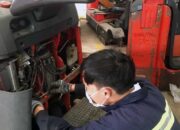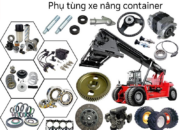Experience in Choosing the Right Container Forklift for Ports and Large Warehouses
In the logistics industry, container forklifts play a critical role in handling and transporting goods at seaports and large warehouses. With containers weighing tens of tons, selecting the right forklift not only optimizes performance but also minimizes operating costs and ensures workplace safety. A suitable forklift enhances productivity, reduces loading/unloading time, and improves warehouse management efficiency. So, how do you choose the most appropriate container forklift for ports and large warehouses?
Common Types of Container Forklifts
To select the right container forklift, you first need to understand the types available on the market. Each type is designed for specific purposes, meeting different needs at ports and large warehouses.
- Empty Container Handler
– Features: Designed specifically for handling empty containers, these forklifts have a lighter capacity, typically 8-10 tons. They can stack empty containers high, saving warehouse space.
– Applications: Suitable for ports or warehouses with high volumes of empty containers, such as import/export ports or transit warehouses.
– Advantages: Fuel-efficient, low operating costs, and easy to maneuver in tight spaces.
– Disadvantages: Not suitable for loaded containers or heavy loads.
- Loaded Container Handler
– Features: Designed to handle loaded containers with capacities of 30-45 tons. These forklifts have robust chassis and powerful engines.
– Applications: Ideal for large seaports or warehouses handling heavy loaded containers.
– Advantages: Capable of handling heavy loads and stable on rough terrain.
– Disadvantages: Higher investment and operating costs compared to empty container handlers.
- Reach Stacker
– Features: The most versatile container forklift, capable of lifting and stacking both empty and loaded containers with extended reach and flexible rotation.
– Applications: Ideal for ports or warehouses requiring long-distance container movement or high stacking.
– Advantages: Versatile, space-efficient, and suitable for various container types.
– Disadvantages: High cost and requires highly skilled operators.
- Sidelift Forklift
– Features: Lifts containers from both sides, suitable for limited spaces or when moving containers without rotating the forklift.
– Applications: Suitable for small warehouses or ports with constrained spaces.
– Advantages: Flexible in tight spaces and efficient for handling empty containers.
– Disadvantages: Limited capacity, not suitable for heavy loaded containers.
Key Factors to Consider When Choosing a Container Forklift
Selecting a container forklift requires careful consideration of specific criteria to ensure it meets the business’s operational needs.
- Container Weight and Size
– Determine the type of containers your business handles (20ft, 40ft, or specialized containers like refrigerated ones). The forklift must have an appropriate capacity, e.g., a loaded container handler needs at least 30 tons for a fully loaded 40ft container.
– Ensure the forklift can handle containers of varying sizes and weights for flexibility.
- Lifting Height and Stacking Capability
– At ports and large warehouses, containers are often stacked high to save space. Choose a forklift with a suitable lifting height, typically 4-6 containers (12-18m).
– Reach stackers are preferred for flexible stacking, while empty container handlers are suitable for warehouses stacking only empty containers.
- Fuel Type
– Diesel Forklifts: Most common, with powerful engines suitable for outdoor ports or warehouses. However, fuel and maintenance costs are higher.
– Electric Forklifts: Environmentally friendly, cost-efficient for operations, ideal for indoor warehouses or areas with emission regulations. The downside is long charging times.
– Hybrid Forklifts: Combine the benefits of both but have a higher initial investment cost.
- Operating Terrain
– For ports with rough terrain or exposure to saltwater, choose forklifts with corrosion-resistant chassis and durable tires.
– For indoor warehouses, electric or sidelift forklifts are optimal due to their maneuverability in tight spaces.
- Brand and Durability
– Trusted brands like Toyota, Hyster, Kalmar, or Linde are favored for their durability and reliable after-sales service.
– Choose suppliers with clear warranty policies and readily available spare parts to minimize downtime during maintenance.
- Maintenance and Spare Parts Costs
– Long-term maintenance costs are a critical factor. Diesel forklifts typically have higher maintenance costs than electric ones.
– Ensure the supplier provides readily available spare parts to avoid operational disruptions.
Practical Experience in Choosing a Container Forklift
To ensure the investment in a container forklift delivers maximum efficiency, here are some practical tips:
– Identify Specific Needs: Evaluate workload, container types, operational frequency, and budget. For example, empty container handlers are more cost-effective than reach stackers for warehouses primarily handling empty containers.
– Test in Real Conditions: Request suppliers to allow testing the forklift in actual operating conditions to assess performance and suitability.
– Seek Feedback: Consult businesses that have used forklifts from the supplier to gain insights into quality and service.
– Negotiate Terms: Don’t focus solely on the initial purchase price; negotiate warranty, maintenance, and spare parts costs.
– Train Operators: Ensure the operating team is well-trained to use the forklift efficiently, minimizing risks and extending equipment lifespan.
Benefits of Choosing the Right Container Forklift
Selecting the right container forklift brings significant benefits to ports and large warehouses:
– Increased Productivity: A suitable forklift speeds up container handling, reduces waiting times, and optimizes logistics processes.
– Reduced Operating Costs: Fuel-efficient or low-maintenance forklifts save significant costs in the long run.
– Improved Safety: High-quality, suitable forklifts minimize accidents and ensure employee safety.
– Enhanced Warehouse Management: Flexible, versatile forklifts support efficient container arrangement and optimize storage space.
Common Mistakes to Avoid When Choosing a Container Forklift
Here are some common mistakes businesses should avoid:
– Choosing an Unsuitable Forklift: For example, purchasing an expensive reach stacker when an empty container handler would suffice for a small warehouse.
– Ignoring Long-Term Maintenance Costs: Focusing only on the initial purchase price without considering maintenance costs can lead to higher operating expenses.
– Overlooking Scalability: If the business plans to expand its warehouse or port, choose a forklift that can meet future demands.
– Buying from Unreliable Suppliers: Suppliers lacking experience or poor after-sales service can disrupt operations.
FAQs About Container Forklifts
– Which forklift is suitable for large warehouses?
Depending on needs, reach stackers are ideal for handling both loaded and empty containers, while sidelift forklifts suit tight spaces.
– What is the average cost of a container forklift?
Prices range from hundreds of millions to billions of VND, depending on the type, capacity, and brand.
– Should you buy a new or used container forklift?
New forklifts offer better quality and warranties, but used ones can be cost-effective if thoroughly inspected.
– How to maintain a container forklift effectively?
Schedule regular maintenance, use genuine spare parts, and train operators properly.
– What are the advantages of electric container forklifts over diesel ones?
Electric forklifts save fuel costs, are environmentally friendly, and are suitable for indoor warehouses, but require charging time.







